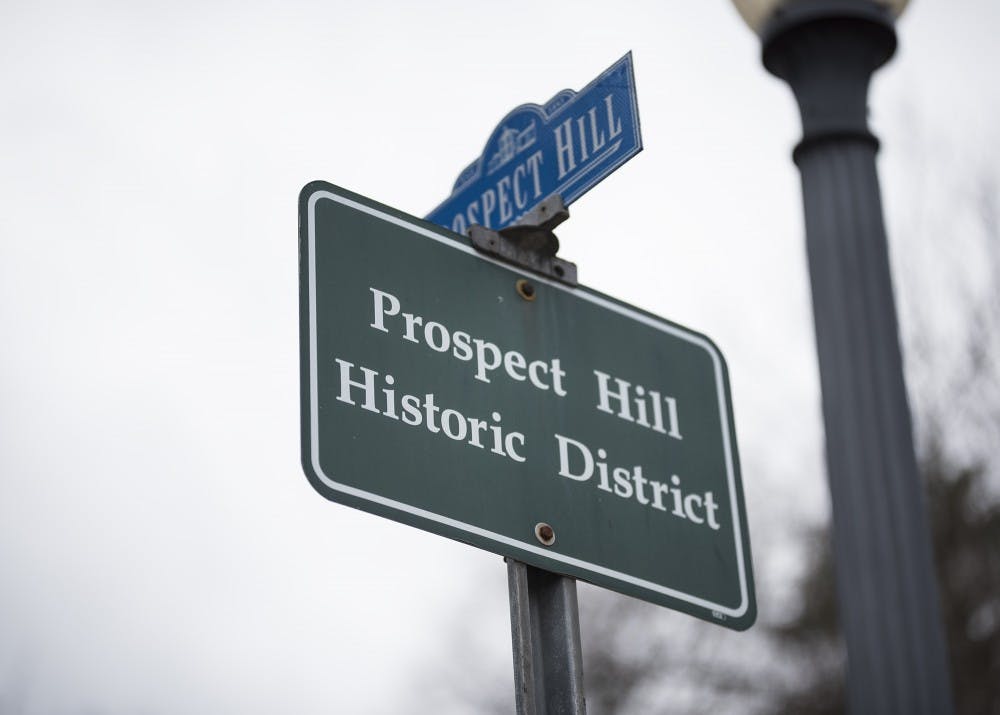Jacob Emery used to run out of his house in the historic Prospect Hill neighborhood to look at the electricity meter every morning during the first week his solar panels were installed.
The panels create more energy than his house consumes, so the meter spins backwards. This excess energy is measured and turned into net-metering credits, which can be used at night or during the winter when the panels are not producing as much energy.
“It feels like I’m magically violating the space-time continuum,” Emery said.
The Historic Preservation Commission has veto-power over any change to homes in historical districts, from replacing a window to installing $10,000 worth of solar panels.
Emery was surprised by the hoops he had to jump through to install solar panels on his roof, which included a commission meeting and having someone present on his behalf. If Emery’s installation was not approved by the commission and he chose to install the panels anyway, he could get fined.
“I thought it would be rubber stamped without controversy,” Emery said. “Which was perhaps foolish of me.”
The tension between wanting sustainable energy and preserving history was clear at the commission’s meeting Sept. 14, where Emery’s petition to install solar panels on his roof was approved, 6-2, after much debate.
“It was touch and go there for a minute,” said Al Jarvis, founder of Solar Systems of Indiana, who attended the meeting to speak on Emery’s behalf.
Chris Sturbaum, a commission member who voted against Emery’s solar panels, said his choice was a matter of trade-offs. As a preservationist, Sturbaum says he likes to see a house how people saw it 100 years ago.
“Some people may consider that solar panels trump everything, but I don’t think that’s a reasonable approach,” Sturbaum said.
The commission approves or denies solar panel installations based on strict national guidelines in combination with guidelines each neighborhood writes. These guidelines vary from each other, especially in the case of Elm Heights and Prospect Hill.
People like Emery in Prospect Hill, a small, quiet cluster of 28 houses just west of campus, struggle to get their projects approved because of his neighborhood guidelines. Residents of Elm Heights, a larger district south of campus, do not have this issue and recently participated in a project to buy panels in bulk.
Thanks to a group of Bloomington High School South students last year, Elm Heights has almost tripled its number of solar systems. IU freshman Katherine Tilghman was one of the founders of Interfaith Community of Environmentalist Youth, a high school group that helped people in Elm Heights buy panels at a discounted rate. They went from 20 systems to about 60 in a year.
“We just really wanted to make a big impact,” Tilghman said.
Tilghman said she sees the conflict between installing solar panels and keeping the home’s historic look, but she hopes people will get inspiration from their neighbors and amend the guidelines.
Solar panel regulations do not just affect people living in historic neighborhoods. Tilghman’s neighborhood, Winslow Farm, which is not historic, bans solar panels altogether.
Tilghman started another initiative in her neighborhood to vote to change the guidelines to allow panels. The voting period ends Dec. 15.
“Solar proponents are more hopeful about this,” Tilghman said. “The biggest obstacle will be getting enough homeowners to vote.”

Jarvis and his team from Solar Systems have been working 10 hour days, six to seven days a week to install all the solar panels on order before the new year starts and Senate Bill 309 goes into effect.
The bill will decrease the net-metering benefits for anyone who installs panels after Dec. 31, 2017. The actual installation takes one to three days, but the other requirements for the homeowner can make the process take months.
Aside from Historic Preservation Commission approval, which can involve a month-long wait for a hearing, the process includes a site visit, a connection agreement with an energy company, and an inspection from the Monroe County Building Requirement.
After Emery’s installation was finished in October, Sturbaum went to look at the 1904 red roofed house, now outfitted with black panels.
“It’s not the prettiest thing in the world,” Sturbaum said. “It does detract from the historic front of the house.”
Jarvis disagreed, saying his team put effort into making the installation look as clean as possible by consciously hiding the wires and conductors.
“When I drive by, I’m like ‘that looks good. I think that looks tight,’” Jarvis said.
As someone who appreciates aesthetics and has written several books on art, Emery said he understands how installing solar panels can change the appearance of the neighborhood. On the other hand, Emery thinks it would be foolish to insist every visible part of the house be kept in the condition it was a century ago.
“Solar panels, like shingles or gutters are detachable elements of the house,” Emery said.




